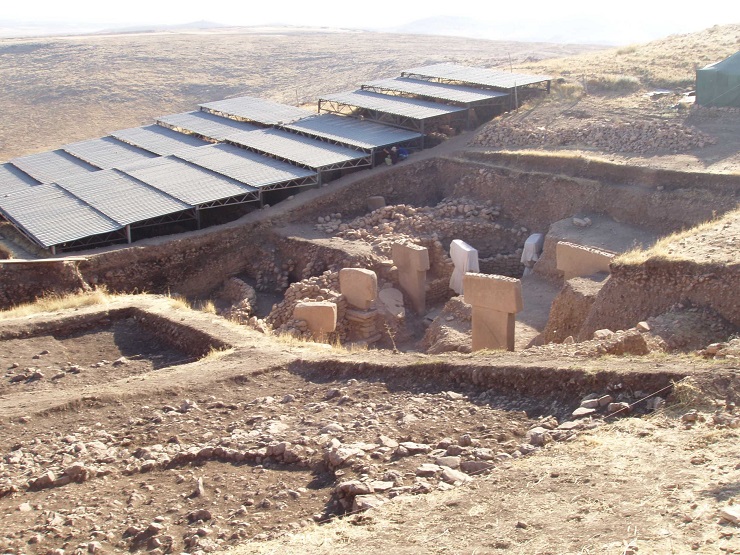The Göbekli Tepe site in southeastern Turkey (the region of Upper Mesopotamia located between the Euphrates and the Tigris rivers) is a unique monument and provides the oldest architectural evidence of what can be achieved through the intervention of a larger amount of manpower. It was Klaus Schmidt’s research, which had been implemented since the mid-1990’s, that revealed its true potential though its actual discovery dates back as far as to the year 1963.
|
|
| MThe megalithic structures dating from the earliest period of Göbekli Tepe were monumental and their construction demanded both a high degree of manpower and also strong leadership. Apparent in this sketchy reconstruction is especially the crucial positioning of the T-pillars (pictured on the right) and it also provides the possibility of creating an overall impression of the status of the buildings subsequent to several reconstructions. According to some experts these structures might have been constructed specifically for observing the celestial bodies. Author Petr Vavrečka. |
It is a hill, the name of which translates into English as Potbelly Hill, which has a 300 m diameter and a height of 15 m, which, in its’ pot-belly first hides it’s either round or oval limestone rock structure, and then it’s rectangular layout, a part of which can be dated to the late 10th millennium BC, thereby to the period of the inception of agriculture! The function of the latest building was terminated sometime at the beginning of the 8th millennium BC.
The basic structural parts of the buildings are defined by their limestone pillars that form the shape of the letter T, which, according to Klaus Schmidt, symbolises the human body. The limestone for these pillars was quarried in a location approximately 100 metres away. Inside the circular structure the other two, probably the main T-pillars, were always placed. During the next phase of the construction the perimeter pillars were connected by dry-laid stonewalls and then there was just one entrance into the building. It is also possible that they were roofed. After the termination of the functioning of each building it was backfilled as a manner of burial. All the structures that were found had been deliberately buried in this way already during the Neolithic period and for this reason they have survived in their final form, virtually unchanged until the present day!
 |
| These mysterious buildings were already “buried” in the period of Pre-pottery Neolithic PPNB. The task for archaeologists is not only to distinguish between the backfill layers and the actual stone buildings, but also to protect any unique structures that have been unearthed for the future. The photograph is of the Göbekli Tepe site during the research that was carried-out in 2004. Photo by K. Vytejčková. |
It seems that due to its location and because nowhere in the immediate vicinity is, nor probably has there ever been, a water source the site was not considered as being suitable for a settlement. Additionally, no sign of any heating devices was found in any of the parts of the site that were explored. Probably this means that these buildings actually fulfilled a ritual function - perhaps as the first temples. About twenty buildings were documented there by excavating them and by recording their geophysical measurements. Especially interesting is the richness of their naturalistic zoomorphic and symbolic decoration.
According to many experts, these building may particularly document the demonstration of the power of individuals or groups. That is to say that someone had to force larger number of residents of communities, apparently from a radius of up to 200 km to build buildings that lacked any practical significance over a period of years and perhaps even for decades. The higher degree of concentration of people during the era of the hunter-gatherers might also have created supply problems. One possible solution could have been the universal usage of wild forms of cereals that were native over a wide area. Some biologists refer to SE Turkey in regard to the oldest cultivated forms of grains, i.e. wheat and barley. Changes in the religion and changes in the social structure apparently preceded the changes in the economic systems rather than representing a consequence of them.
Want to learn more?
- Schmidt, K. 2007: Sie bauten die ersten Tempel. Das rätselhafte Heiligtum der Steinzeitjäger. München: Verlag C. H. Beck; Schmidt, K. 2011: Göbekli Tepe. In: M. Özdogan – N. Başgelen – P. Kuniholm: The Neolithic in Turkey. New Excavations & New Research. Istanbul: Archaeology & Art Publications, 41-83.
- Schmidt, K. 2011: Göbekli Tepe: A Neolithic Site in Southeastern Anatolia. In: S. R. Steadman – G. McMahon (eds.): The Oxford Handbook of ancient Anatolia. Oxford: Oxford University press, 917-933.
 Archeologické 3D virtuální muzeum
Archeologické 3D virtuální muzeum

.jpg)
